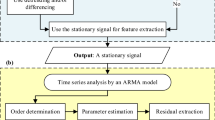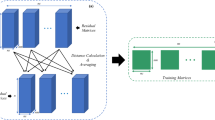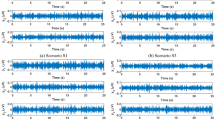Abstract
Structural damage detection is crucial for ensuring the safety and reliability of civil infrastructure. In this paper, we propose a novel vibration-based structural damage detection framework using spectral distance and a combination of t-Distributed Stochastic Neighbor Embedding (t-SNE) and Gaussian Mixture Model (GMM). By integrating these three procedures, a unique, comprehensive, and highly effective approach for detecting structural damage is achieved. First, we extract spectral distance-based features from structural response data under ambient excitations, which provide information about the deviation of the spectral content of the signal from the undamaged structural response. Then we apply t-SNE to embed the dimensional data into lower dimensional feature space and visualize the data in a low-dimensional space. Finally, we use GMM-based clustering to classify the data into normal and anomalous classes. To evaluate the proposed approach, the experimental data from the Phase II Experimental Benchmark Problem on Structural Health Monitoring, introduced by the IASC-ASCE Structural Health Monitoring Task Group, is utilized. The results show that our method can effectively detect structural damage anomalies. Moreover, the proposed framework is computationally efficient, making it suitable for real-time Structural Health Monitoring (SHM) applications. This paper presents novel structural damage indicators (SDI) based on power spectral density (PSD) deviations between damaged and undamaged structural responses. The study compares the performance of proposed spectral distance measures and emphasizes the significance of spectral Kullback–Leibler distance as an indicator of structural deterioration. In addition, the effectiveness of t-SNE–GMM is demonstrated in efficiently segregating damage configurations.











Similar content being viewed by others
Data availability
No datasets were generated or analysed during the current study.
References
Abdeljaber, O., Avci, O., Kiranyaz, S., Gabbouj, M., & Inman, D. J. (2017). Real-time vibration-based structural damage detection using one-dimensional convolutional neural networks. Journal of Sound and Vibration, 388, 154–170.
Amezquita-Sanchez, J. P., & Adeli, H. (2016). Signal processing techniques for vibration-based health monitoring of smart structures. Archives of Computational Methods in Engineering, 23, 1–15.
Avci, O., Abdeljaber, O., Kiranyaz, S., & Inman, D. (2020). Convolutional neural networks for real-time and wireless damage detection. In Dynamics of Civil Structures, Volume 2: Proceedings of the 37th IMAC, A conference and exposition on structural dynamics 2019 (pp. 129–136). Springer International Publishing.
Avci, O., Abdeljaber, O., Kiranyaz, S., Hussein, M., Gabbouj, M., & Inman, D. J. (2021). A review of vibration-based damage detection in civil structures: From traditional methods to machine learning and deep learning applications. Mechanical Systems and Signal Processing, 147, 107077.
Bandara, R. P., Chan, T. H., & Thambiratnam, D. P. (2014). Structural damage detection method using frequency response functions. Structural Health Monitoring, 13(4), 418–429.
Bao, Y., & Li, H. (2021). Machine learning paradigm for structural health monitoring. Structural Health Monitoring, 20(4), 1353–1372.
Betti, M., Facchini, L., & Biagini, P. (2015). Damage detection on a three-storey steel frame using artificial neural networks and genetic algorithms. Meccanica, 50, 875–886.
Bishop, C. (2006). Pattern recognition and machine learning. Springer Google Schola, 2, 531–537.
Buckley, T., Ghosh, B., & Pakrashi, V. (2023). A feature extraction & selection benchmark for structural health monitoring. Structural Health Monitoring, 22(3), 2082–2127.
Caicedo, J. M. (2011). Practical guidelines for the natural excitation technique (NExT) and the eigensystem realization algorithm (ERA) for modal identification using ambient vibration. Experimental Techniques, 35, 52–58.
Carden, E. P., & Brownjohn, J. M. (2008). ARMA modelled time-series classification for structural health monitoring of civil infrastructure. Mechanical Systems and Signal Processing, 22(2), 295–314.
Chang, K. C., & Kim, C. W. (2016). Modal-parameter identification and vibration-based damage detection of a damaged steel truss bridge. Engineering Structures, 122, 156–173.
Chen, Y. (2023). Vibration-based structural damage localisation using time response correlation. Nondestructive Testing and Evaluation, 38(1), 112–129.
Chesné, S., & Deraemaeker, A. (2013). Damage localization using transmissibility functions: A critical review. Mechanical Systems and Signal Processing, 38(2), 569–584.
Chun, P. J., Yamashita, H., & Furukawa, S. (2015). Bridge damage severity quantification using multipoint acceleration measurement and artificial neural networks. Shock and Vibration, 2015, 1–11.
Cury, A., & Crémona, C. (2012). Pattern recognition of structural behaviors based on learning algorithms and symbolic data concepts. Structural Control and Health Monitoring, 19(2), 161–186.
Dang, H. V., Tran-Ngoc, H., Nguyen, T. V., Bui-Tien, T., De Roeck, G., & Nguyen, H. X. (2020). Data-driven structural health monitoring using feature fusion and hybrid deep learning. IEEE Transactions on Automation Science and Engineering, 18(4), 2087–2103.
Doebling, S. W., Farrar, C. R., Prime, M. B., & Shevitz, D. W. (1996). Damage identification and health monitoring of structural and mechanical systems from changes in their vibration characteristics: a literature review.
Dyke, S. J., Bernal, D., Beck, J., & Ventura, C. (2003). Experimental phase II of the structural health monitoring benchmark problem. In Proceedings of the 16th ASCE engineering mechanics conference.
Entezami, A., Sarmadi, H., Salar, M., De Michele, C., & Arslan, A. N. (2021). A novel data-driven method for structural health monitoring under ambient vibration and high-dimensional features by robust multidimensional scaling. Structural Health Monitoring, 20(5), 2758–2777.
Fawad, M., Salamak, M., Poprawa, G., Koris, K., Jasinski, M., Lazinski, P., & Gerges, M. (2023). Automation of structural health monitoring (SHM) system of a bridge using BIMification approach and BIM-based finite element model development. Scientific Reports, 13(1), 13215.
Frizzarin, M., Feng, M. Q., Franchetti, P., Soyoz, S., & Modena, C. (2010). Damage detection based on damping analysis of ambient vibration data. Structural Control and Health Monitoring: THe Official Journal of the International Association for Structural Control and Monitoring and of the European Association for the Control of Structures, 17(4), 368–385.
Gray, A., & Markel, J. (1976). Distance measures for speech processing. IEEE Transactions on Acoustics, Speech, and Signal Processing, 24(5), 380–391.
Gui, G., Pan, H., Lin, Z., Li, Y., & Yuan, Z. (2017). Data-driven support vector machine with optimization techniques for structural health monitoring and damage detection. KSCE Journal of Civil Engineering, 21, 523–534.
Gul, M., & Catbas, F. N. (2008). Ambient vibration data analysis for structural identification and global condition assessment. Journal of Engineering Mechanics, 134(8), 650–662.
Gul, M., & Catbas, F. N. (2011). Damage assessment with ambient vibration data using a novel time series analysis methodology. Journal of Structural Engineering, 137(12), 1518–1526.
Ibrahim, A., Eltawil, A., Na, Y., & El-Tawil, S. (2019). A machine learning approach for structural health monitoring using noisy data sets. IEEE Transactions on Automation Science and Engineering, 17(2), 900–908.
Indhu, R., Sundar, G. R., & Parveen, H. S. (2022, February). A Review of machine learning algorithms for vibration-based SHM and vision-based SHM. In 2022 Second international conference on artificial intelligence and smart energy (ICAIS) (pp. 418–422). IEEE.
Itakura, F. (1968). Analysis synthesis telephony based on the maximum likelihood method. Reports of the 6^< th> Int. Cong. Acoust., 1968.
Kamariotis, A., Chatzi, E., & Straub, D. (2022). Value of information from vibration-based structural health monitoring extracted via Bayesian model updating. Mechanical Systems and Signal Processing, 166, 108465.
Kamariotis, A., Chatzi, E., & Straub, D. (2023). A framework for quantifying the value of vibration-based structural health monitoring. Mechanical Systems and Signal Processing, 184, 109708.
Kaveh, A., & Dadras, A. (2018). Structural damage identification using an enhanced thermal exchange optimization algorithm. Engineering Optimization, 50(3), 430–451.
Kaveh, A., & Maniat, M. (2015). Damage detection based on MCSS and PSO using modal data. Smart Structures and Systems, 15(5), 1253–1270.
Kaveh, A., Rahmani, P., & Dadras Eslamlou, A. (2022). Guided water strider algorithm for structural damage detection using incomplete modal data. Iranian Journal of Science and Technology, Transactions of Civil Engineering, 46(2), 771–788.
Krishnan Nair, K., & Kiremidjian, A. S. (2007). Time series based structural damage detection algorithm using Gaussian mixtures modeling. Journal of Dynamic Systems, Measurement, and Control. https://doi.org/10.1115/1.2718241
Kullback, S., & Leibler, R. A. (1951). On information and sufficiency. The Annals of Mathematical Statistics, 22(1), 79–86.
Lai, X., Kan, Z., Sun, W., Song, X., Tian, B., & Yuan, T. (2023). Digital twin-based non-destructive testing for structural health monitoring of bridges. Nondestructive Testing and Evaluation. https://doi.org/10.1080/10589759.2023.2239434
Maes, K., et al. (2022). Validation of vibration-based structural health monitoring on retrofitted railway bridge KW51. Mechanical Systems and Signal Processing, 165, 108380.
Maia, N. M. M., et al. (2003). Damage detection in structures: From mode shape to frequency response function methods. Mechanical Systems and Signal Processing, 17(3), 489–498.
Meruane, V. (2016). Online sequential extreme learning machine for vibration-based damage assessment using transmissibility data. Journal of Computing in Civil Engineering, 30(3), 04015042.
Padil, K. H., Bakhary, N., Abdulkareem, M., Li, J., & Hao, H. (2020). Non-probabilistic method to consider uncertainties in frequency response function for vibration-based damage detection using Artificial neural network. Journal of Sound and Vibration, 467, 115069.
Pal, A., Kundu, T., & Datta, A. K. (2023). Damage localization in Rail Section using single AE sensor data: An experimental investigation with deep learning approach. Nondestructive Testing and Evaluation. https://doi.org/10.1080/10589759.2023.2243004
Pan, Q., Bao, Y., & Li, H. (2023). Transfer learning-based data anomaly detection for structural health monitoring. Structural Health Monitoring. https://doi.org/10.1177/14759217221142174
Parziale, M., Lomazzi, L., Giglio, M., & Cadini, F. (2022). Vibration-based structural health monitoring exploiting a combination of convolutional neural networks and autoencoders for temperature effects neutralization. Structural Control and Health Monitoring, 29(11), e3076.
Pathirage, C. S. N., Li, J., Li, L., Hao, H., Liu, W., & Ni, P. (2018). Structural damage identification based on autoencoder neural networks and deep learning. Engineering Structures, 172, 13–28.
Pawar, P. M., Venkatesulu Reddy, K., & Ganguli, R. (2007). Damage detection in beams using spatial Fourier analysis and neural networks. Journal of Intelligent Material Systems and Structures, 18(4), 347–359.
Radzieński, M., Krawczuk, M., & Palacz, M. (2011). Improvement of damage detection methods based on experimental modal parameters. Mechanical Systems and Signal Processing, 25(6), 2169–2190.
Roy, P., Datta, A. K., & Topdar, P. (2023). A study on the efficacy of modal acoustic emission technique for health monitoring of structures with different geometries. Nondestructive Testing and Evaluation. https://doi.org/10.1080/10589759.2023.2231611
Santos, A., Figueiredo, E., Silva, M. F. M., Sales, C. S., & Costa, J. C. W. A. (2016). Machine learning algorithms for damage detection: Kernel-based approaches. Journal of Sound and Vibration, 363, 584–599.
Silva, M., Santos, A., Figueiredo, E., Santos, R., Sales, C., & Costa, J. C. (2016). A novel unsupervised approach based on a genetic algorithm for structural damage detection in bridges. Engineering Applications of Artificial Intelligence, 52, 168–180.
Toh, G., & Park, J. (2020). Review of vibration-based structural health monitoring using deep learning. Applied Sciences, 10(5), 1680.
Van der Maaten, L., & Hinton, G. (2008). Visualizing data using t-SNE. Journal of machine learning research, 9(11)
Wahab, M. A., & De Roeck, G. (1999). Damage detection in bridges using modal curvatures: Application to a real damage scenario. Journal of Sound and Vibration, 226(2), 217–235.
Yang, Y., Zhang, Y., & Tan, X. (2021). Review on vibration-based structural health monitoring techniques and technical codes. Symmetry, 13(11), 1998.
Yeung, W. T., & Smith, J. W. (2005). Damage detection in bridges using neural networks for pattern recognition of vibration signatures. Engineering Structures, 27(5), 685–698.
Yin, T., Lam, H. F., Chow, H. M., & Zhu, H. P. (2009). Dynamic reduction-based structural damage detection of transmission tower utilizing ambient vibration data. Engineering Structures, 31(9), 2009–2019.
Yu, L., & Zhu, J. H. (2015). Nonlinear damage detection using higher statistical moments of structural responses. Structural Engineering and Mechanics, 54(2), 221–237.
Yu, Y., Wang, C., Gu, X., & Li, J. (2019). A novel deep learning-based method for damage identification of smart building structures. Structural Health Monitoring, 18(1), 143–163.
Zhou, X. T., Ni, Y. Q., & Zhang, F. L. (2014). Damage localization of cable-supported bridges using modal frequency data and probabilistic neural network. Mathematical Problems in Engineering, 2014.
Funding
There is no funding received by the authors to carry out the present work.
Author information
Authors and Affiliations
Contributions
S. K. Laha developed the methodology and the relevant computer codes. All authors wrote the main manuscript. All authors reviewed the manuscript.
Corresponding author
Ethics declarations
Conflict of interest
The authors declare that they have no conflict of interest, whatsoever related to this manuscript.
Additional information
Publisher's Note
Springer Nature remains neutral with regard to jurisdictional claims in published maps and institutional affiliations.
Rights and permissions
Springer Nature or its licensor (e.g. a society or other partner) holds exclusive rights to this article under a publishing agreement with the author(s) or other rightsholder(s); author self-archiving of the accepted manuscript version of this article is solely governed by the terms of such publishing agreement and applicable law.
About this article
Cite this article
Laha, S.K., Swarnakar, B. & Kansabanik, S. Anomaly detection in Structural Health Monitoring using spectral distance and t-SNE–GMM framework under ambient excitation. Asian J Civ Eng 25, 3711–3727 (2024). https://doi.org/10.1007/s42107-024-01006-y
Received:
Accepted:
Published:
Issue Date:
DOI: https://doi.org/10.1007/s42107-024-01006-y




